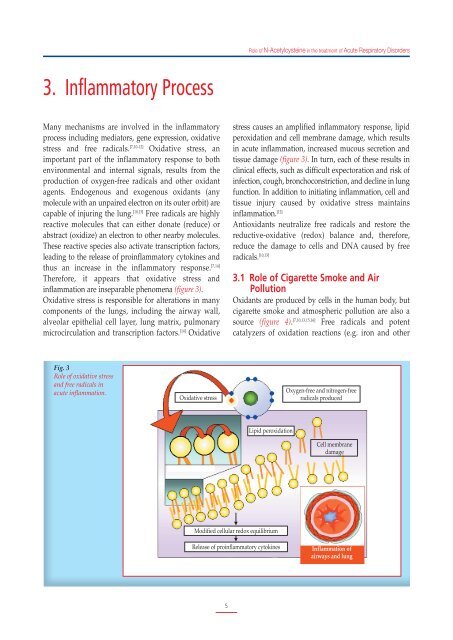Therapeutics
Role of N-Acetylcysteine
Role of N-Acetylcysteine
- No tags were found...
Create successful ePaper yourself
Turn your PDF publications into a flip-book with our unique Google optimized e-Paper software.
Role of N-Acetylcysteine in the treatment of Acute Respiratory Disorders<br />
3. Inflammatory Process<br />
Many mechanisms are involved in the inflammatory<br />
process including mediators, gene expression, oxidative<br />
stress and free radicals. [7,10-12] Oxidative stress, an<br />
important part of the inflammatory response to both<br />
environmental and internal signals, results from the<br />
production of oxygen-free radicals and other oxidant<br />
agents. Endogenous and exogenous oxidants (any<br />
molecule with an unpaired electron on its outer orbit) are<br />
capable of injuring the lung. [10,13] Free radicals are highly<br />
reactive molecules that can either donate (reduce) or<br />
abstract (oxidize) an electron to other nearby molecules.<br />
These reactive species also activate transcription factors,<br />
leading to the release of proinflammatory cytokines and<br />
thus an increase in the inflammatory response. [7,14]<br />
Therefore, it appears that oxidative stress and<br />
inflammation are inseparable phenomena (figure 3).<br />
Oxidative stress is responsible for alterations in many<br />
components of the lungs, including the airway wall,<br />
alveolar epithelial cell layer, lung matrix, pulmonary<br />
microcirculation and transcription factors. [14] Oxidative<br />
stress causes an amplified inflammatory response, lipid<br />
peroxidation and cell membrane damage, which results<br />
in acute inflammation, increased mucous secretion and<br />
tissue damage (figure 3). In turn, each of these results in<br />
clinical effects, such as difficult expectoration and risk of<br />
infection, cough, bronchoconstriction, and decline in lung<br />
function. In addition to initiating inflammation, cell and<br />
tissue injury caused by oxidative stress maintains<br />
inflammation. [12]<br />
Antioxidants neutralize free radicals and restore the<br />
reductive-oxidative (redox) balance and, therefore,<br />
reduce the damage to cells and DNA caused by free<br />
radicals. [10,13]<br />
3.1 Role of Cigarette Smoke and Air<br />
Pollution<br />
Oxidants are produced by cells in the human body, but<br />
cigarette smoke and atmospheric pollution are also a<br />
source (figure 4). [7,10,13,15,16] Free radicals and potent<br />
catalyzers of oxidation reactions (e.g. iron and other<br />
Fig. 3<br />
Role of oxidative stress<br />
and free radicals in<br />
acute inflammation.<br />
Oxidative stress<br />
Oxygen-free and nitrogen-free<br />
radicals produced<br />
Lipid peroxidation<br />
Cell membrane<br />
damage<br />
Modified cellular redox equilibrium<br />
Release of proinflammatory cytokines<br />
Inflammation of<br />
airways and lung<br />
5


